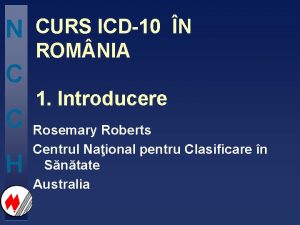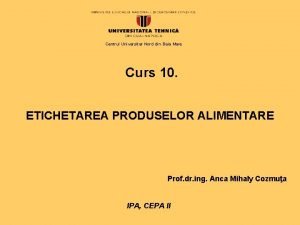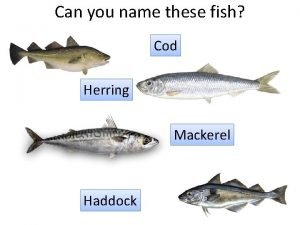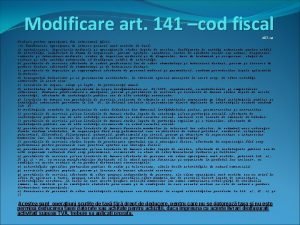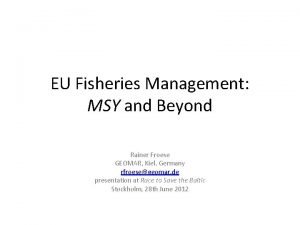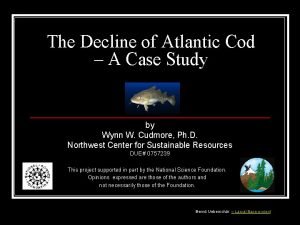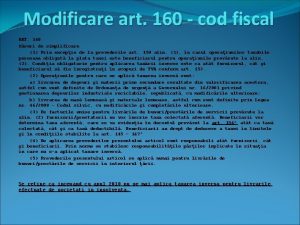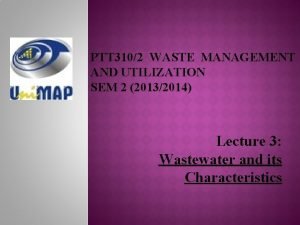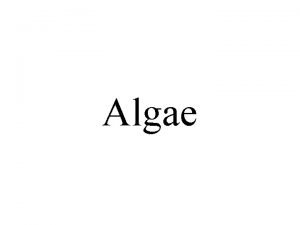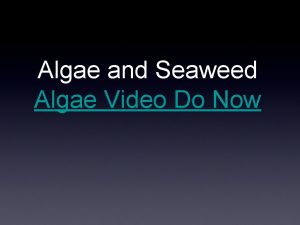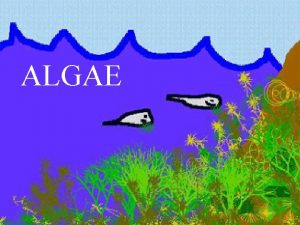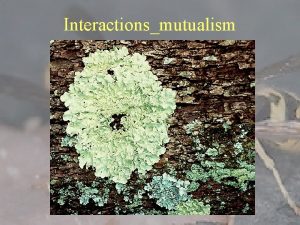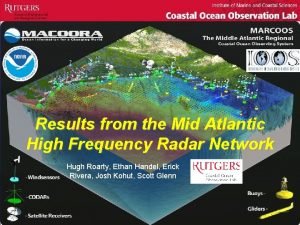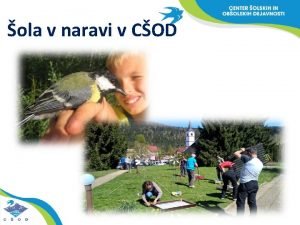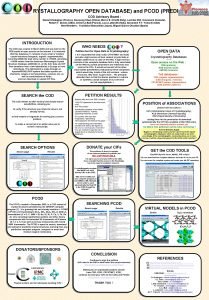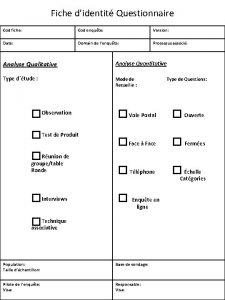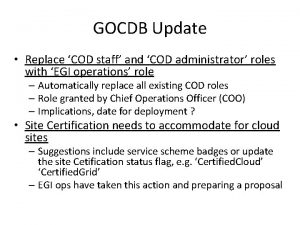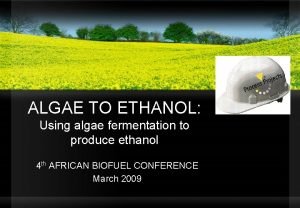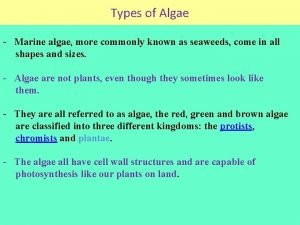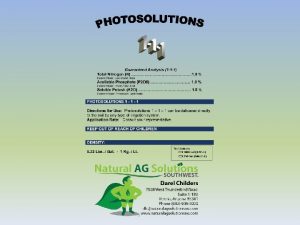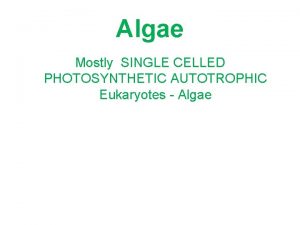Algae Control on Cape Cod Key Factors Results



























- Slides: 27

Algae Control on Cape Cod: Key Factors, Results and Lessons Ken Wagner, Ph. D. , CLM Water Resource Services, Inc.

Cape Cod, Massachusetts Ø Glacial history Ø Human use history

Kettlehole Ponds Ø Glacial potholes Ø Sandy soils Ø Depths to 27 m, often >10 m Ø Low surface watershed areas Ø Few inlets, often no surface outlet Ø Depend on precipitation and ground water Ø Long detention times

Bathymetry of Kettleholes Ø Generally bowl shaped, but considerable variation possible Ø Often steep side slopes, sandy

Watershed Influences and Pond Conditions Ø Pine and oak scrub on sandy soils Ø Residential/related development Ø Historic agriculture Ø Cranberry bogs Ø Backround WQ: low p. H (<6. 5), alkalinity (<10 mg/L), TP (<10 µg/L), TN (<300 µg/L), chl a (<4 µg/L), high Secchi (>5 m) Ø Slow accumulation of organic matter Ø High Fe-P in sediment

Kettlehole Problems Ø Limited rooted plant issues; surprisingly few invasives, including mainly variable milfoil, fanwort, and hydrilla Ø Cyanobacteria blooms can be severe with increase in fertility, drastically alters water quality

Cyanobacteria Blooms on Cape Cod Ø Fairly varied, but most commonly Dolichospermum (Anabaena), esp D. lemmermannii or D. variabilis, Aphanizomenon flos-aquae, Microcystis spp. , and Planktothrix rubescens, some Pseudanabaena and Planktolyngbya Ø Dolichospermum blooms can appear quickly from rapid rise of colonies grown to maturity on sediment Ø Aphanizomenon and Microcystis blooms tend to develop more slowly (seeded from sediment with expansion in surface water) Ø Planktothrix blooms develop just below thermocline, rise to surface with mixing

Internal P Loading as a Driving Force Ø Largely linked to P bound by Fe and released under anoxia Ø Largely a summer phenomenon, during stratification and anoxic periods Ø Can be more than half of the annual load Ø Even if only 25% of the annual load, can be the dominant summer P source Ø Tends to come with low N: P ratio (<5: 1) Ø Ecology of some cyanos promotes uptake near sediment followed by upward movement to form blooms

Key Role of Oxygen Ø Oxygen keeps P bound to Fe; even 1 -2 mg/L will minimize P release Ø The higher in the water column anoxia extends from the bottom, the greater the exposed area and potential P release Ø If anoxia approaches thermocline, availability of P to algae increases substantially

Management Options Ø Watershed management can’t control internal loading Ø Some in-lake options address symptoms – useful but not preferred over nutrient control (sonication, algaecides) Ø In-lake options that address internal P loading Flushing/hypolim. withdrawal – remove poor quality water Dredging – remove the source sediment Oxygenation – maintain Fe-P bonds Circulation – oxygenates plus possible symptom control if deep enough or biological structure is favorable v Inactivation – replace Fe binding of P with Al, Ca, or La v v

In-lake P Control Track Record on Cape Cod Ø No flushing or hypolim. withdrawal – no extra water, few outlets Ø Very little dredging performed; some reverse layering, some small pond work, usually cost prohibitive Ø Oxygenation rarely practiced; applicable and would improve cold water fisheries, but high operating costs Ø Circulation by updraft pumps with a few examples; limited improvement, still have summer blooms

Track Record on Cape Cod Ø Circulation by compressed air with few examples; one spectacular failure of implementation/operation

Track Record on Cape Cod Ø Inactivation experience using aluminum has generally been positive Ø 9 lakes treated so far, one repeat so far Ø One repeat and one new application planned in 2015/16

Track Record on Cape Cod: Aluminum Treatments Key attributes of Cape Cod treatment ponds

Track Record on Cape Cod: Loading ØHydrologic load dominated by precipitation and groundwater ØPhosphorus load includes major internal load

Track Record on Cape Cod: Algae Control ØLow biomass, but not necessarily low productivity ØShift away from cyanobacteria ØDiatoms, goldens and dinoflagellates most abundant ØSometimes greens if N levels elevated ØGreater edibility by zooplankton, better energy flow in aquatic food web

Track Record on Cape Cod: Algae Control ØUsually get rapid results, but where water column P is elevated at start of treatment, may take several years to reach new equilibrium ØMystic Planktothrix bloom prior to treatment, mixed assemblage after treatment with Pseudanabaena peaks

Track Record on Cape Cod: Water Clarity ØLower algal biomass leads to marked increase in clarity Herring Pond clarity June 97 -06 July 97 -06 Aug 97 -06 Sept 97 -06 June, 08 July, 08 Aug, 08 Sept, 08 June, 09 July, 09 Sept, 09 June, 10 Aug, 10 June, 11 July, 11 Aug , 11 Sept, 11 June, 12 July, 12 Aug, 12 Sept, 12 June, 13 July, 13 Aug, 13 Sept, 13 Long Pond Secchi Disk Transparencies LP-1 in gray, LP-2 in black 0. 0 1. 0 Treatment Depth (m) 2. 0 3. 0 4. 0 5. 0 6. 0 7. 0 Treatment

Track Record on Cape Cod: P Concentrations ØAluminum treatment leads to lower P levels as a function of reduced release during anoxic periods Mystic Lake whole lake P mass

Track Record on Cape Cod: Oxygen Demand Ø Oxygen demand declines as a function of less decaying algae Ø Anoxia still develops, but not throughout hypolimnion Ø Creates “trout water” – portion of cold hypolimnion with enough oxygen to support trout

Track Record on Cape Cod: Oxygen Demand Ø Oxygen demand varies among years Ø Decline does not appear consistent among lakes Oxygen demand in Long Pond before and after treatment in late 2007

Track Record on Cape Cod: Toxicity Ø Hamblin Pond fish kill in 1995; none since then Ø Toxicity prevention v Maintain p. H between 6 and 8 (close to 7 preferred) v Keep dose under 5 mg Al/L (divide dose in g/m 2 by mixing depth in meters) v Treat in non-contiguous patchwork; provide refuge v Release chemicals near thermocline (if epilimnetic P already low enough)

Track Record on Cape Cod: Duration of Benefits Ø Duration of benefits is a function of ongoing external load and effectiveness of internal load inactivation Ø Spreadsheet model applied, shows return rate to problem P level Ø Hamblin Pond case history Ø Treated in 1995; prediction was for 17 years of benefit Ø First bloom in late Sept 2013; Dolichospermum for 2 weeks Ø Cyano blooms from mid-July on in 2014 Ø Termination of benefits rapid, reason not clear, but have two hypotheses

Track Record on Cape Cod: Duration of Benefit Ø Latest sediment Fe-P data show values of 392 -1142 mg/kg Ø Accumulated Fe-P or simultaneous breakthrough?

Track Record on Cape Cod: Treatment Timing Ø Fall vs. spring treatment poses interesting issues Ø Seasonality of non-target impact potential Ø Lowest P in water column/greatest P in sediment favors spring treatment Ø Limited stripping efficiency in water column limits impact of fall treatments

Track Record on Cape Cod: Overall Pond Fertility Ø Fertility not eliminated – fishing still good, better in some cases Ø Shifts algae away from cyanobacteria, better food web energy flow Ø Clarity higher, algal standing crop smaller, but productivity not necessarily lower

Inactivated yet? I sure am! QUESTIONS?
 Cape cod aphg
Cape cod aphg Ford transit cape cod
Ford transit cape cod Cape cod community college moodle
Cape cod community college moodle Aslp cape cod
Aslp cape cod Customer relationship of business model canvas
Customer relationship of business model canvas Business model canvas tripadvisor
Business model canvas tripadvisor Cod icd 10 stomatologie
Cod icd 10 stomatologie Hétérophorie verticale
Hétérophorie verticale Cours cod 1 pompier
Cours cod 1 pompier Formation cod 1
Formation cod 1 Calcul indice de pompe pompier
Calcul indice de pompe pompier Ee cod
Ee cod Cod tara romania 642
Cod tara romania 642 Mackerel vs herring
Mackerel vs herring Rainer mariner cod
Rainer mariner cod Art 141 cod fiscal
Art 141 cod fiscal Une phrase avec un cod
Une phrase avec un cod Rainer froese
Rainer froese Rainer mariner cod
Rainer mariner cod North atlantic cod case study
North atlantic cod case study Algoritmi scratch
Algoritmi scratch Art 160 cod fiscal
Art 160 cod fiscal Clasificatia organizationala
Clasificatia organizationala Cod pic erasmus
Cod pic erasmus Difference between dry gum and wet gum method
Difference between dry gum and wet gum method Pseudokod primjeri
Pseudokod primjeri Nstm 505
Nstm 505 Bod and cod
Bod and cod






